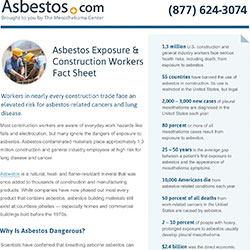Terry was a gifted athlete whose strength and determination brought him to the U.S. in 1970. He worked construction for almost 10 years, where he likely was exposed to asbestos. “I was unlucky to have gotten this disease, but have absolutely no regrets. I worked and worked and worked, made and lost a couple of fortunes. Life has been a pleasure here.”
Construction Workers and Asbestos Exposure
Construction workers have a high risk of occupational asbestos exposure and of developing mesothelioma. Asbestos found in contaminated construction materials such as paint, spackling, roof shingles, masonry compounds and drywall can be inhaled, which may lead to mesothelioma in construction workers.

How Are Construction Workers Exposed to Asbestos?
Construction workers breathe in asbestos when they cut, drill or change materials that contain it. This can release asbestos dust, which spreads quickly through the air on construction sites. Reports from The Centers for Disease Control and Prevention show about 1.3 million construction and general industry workers come into contact with asbestos on the job every year.
Asbestos breaks apart easily, and its tiny fibers turn into dust. When workers breathe in this dust, the fibers can get stuck in their lungs. This can lead to serious health problems, including mesothelioma. Workers can also carry asbestos dust home on their clothes, leading to secondary exposure of family members.
Ways Asbestos Exposure Happens in Construction
- Cutting or otherwise altering asbestos-containing products
- Demolition of asbestos-containing materials, such as roofing, insulation, wallboard or tiles
- Handling asbestos-containing construction materials for installation, removal or repair
Most construction workers today experience asbestos exposure during renovation or demolition of structures where legacy asbestos products remain. While reclaimed older materials or those imported from abroad where asbestos is still actively used could pose a risk, most asbestos materials have been phased out of use. Partial asbestos bans, including the recent March 2024 Environmental Protection Agency asbestos ban on chrysotile, have significantly reduced the presence of asbestos in new construction.
Manufacturers used asbestos in construction materials until the 1980s and 1990s. They chose it because it’s strong and has fireproofing properties. Back then, construction workers often worked with these materials and breathed in asbestos. Many of those workers are now getting diagnosed with asbestos-related diseases.
Types of Construction Jobs With Risks of Asbestos Exposure
Construction jobs involving direct contact with asbestos materials have the highest risk of exposure. These include masonry workers who use asbestos-containing concrete, demolition crews, insulation installers, plumbers and roofers. People in these roles often work with materials known to contain asbestos.
Higher-Risk Construction Trades
Even though some of these jobs have the highest risk for asbestos exposure, many other construction workers can still be in danger. Asbestos dust is fine and spreads easily around a job site. Air systems can move the dust through buildings. If workers don’t wear the right respirators, they can breathe in the dust, elevating their risk of an asbestos-related disease.

You shouldn’t have to choose between getting care and paying for it. Get the financial support you deserve.
See My OptionsBricklayers and Masons
Today, bricklayers and masons can be exposed to asbestos when they cut or tear down bricks. In the past, many concrete products had asbestos mixed into them. Workers were exposed when they mixed the raw asbestos into the blocks, bricks, mortar and other masonry materials.
When masonry workers remove building products like asbestos cement sheets, dust levels can exceed safe limits. Using power tools like saws and drills makes the problem even worse, releasing more dust into the air.
Carpenters
Carpenters often remodel houses and commercial buildings. Many of these buildings were built when asbestos was commonly used. Carpenters may have to cut through old insulation and drywall that contain asbestos or remove floor and ceiling tiles with asbestos added to make them fireproof.
Cutting or disturbing these materials can release asbestos dust into the air. Before 1980, many carpenters worked with asbestos sheets and had to cut them to fit different jobs. This often left them covered in asbestos dust.
A comprehensive 2023 study published in Environmental Research found construction workers top the list of job titles among people with mesothelioma in the U.S. This report also referenced a British study that found former carpenters in the U.K. face one of the highest risks for asbestos-related cancer. Data in the British report showed carpenters were 34 times more likely to get mesothelioma than the average person.
Drywall Workers
Drywall workers can be exposed to asbestos when they cut or remove drywall and plaster that contain the toxic mineral. This work sends harmful dust into the air, which workers can inhale.
In the past, workers were also exposed while plastering or patching holes using joint compounds with asbestos. Before the U.S. Consumer Product Safety Commission banned it in 1977, manufacturers added chrysotile asbestos to many drywall joint compounds. A 2022 study in the Annals of Work Exposures and Health found 24% of Canadian drywall workers had job-related asbestos exposure.
Painters
Painters can be exposed to asbestos today when they sand, scrape or disturb textured coatings that contain it. Before asbestos rules were in place, painters often sprayed spackling compounds with asbestos to create textured surfaces. Some paints and coatings, like popcorn ceilings, also had asbestos in them.
Several cancer registries have found higher rates of mesothelioma and lung cancer in former painters. A recent study ranked painters among the top 5 trades with the highest exposure to dangerous chemicals and toxic materials.
Roofers
Roofers can be exposed to asbestos when they remove old roofing materials. In the past, many homes and commercial buildings used roofing products with asbestos because it helped prevent fires. A 2022 study also found weathering from sun, rain and wind can break down asbestos cement roofing and create dangerous dust that roofers may breathe in.
Tile Setters
Tile setters can be exposed to asbestos when broken or damaged tiles release fibers into the air. In the past, they also faced exposure while mixing and spreading grout that contained asbestos.
Today, vinyl and other flooring tiles no longer use asbestos, but it was very common in the past. A 2021 study found some old vinyl flooring contained up to 25% chrysotile asbestos.
Asbestos Products Associated With Construction Workers
Many construction products may still contain asbestos. These include old paint, spackling, roof shingles, masonry compounds and drywall. Over the past 100 years, manufacturers created thousands of commercial construction materials made with asbestos.
They often added the material to make products stronger and fire-resistant. According to the EPA, most of the 733,000 public and commercial buildings in the U.S. still have asbestos inside.
Asbestos-Containing Construction Products
While the EPA banned chrysotile in 2024, it may take several years to fully phase out these uses. Right now, U.S. laws still let construction companies use some asbestos products if they meet government rules. These products include roofing felt and coatings, millboard, pipeline wrap, vinyl floor tiles, cement sheets, shingles, pipes and nonroofing coatings. Older buildings, historic renovations and projects in other countries are still especially risky regarding asbestos exposure.
Manufacturers of Products Construction Workers Use
Some of the most well-known companies that used asbestos in their products were W.R. Grace, Johns Manville, Owens Corning and Celotex. Later on, many of these companies faced lawsuits because they exposed workers to asbestos and the health risks that came with it.
Manufacturers of Asbestos Products
Experienced construction workers can sometimes identify asbestos based on how it looks, its label, who installed it or the company that made it. But if you aren’t trained to recognize asbestos or can’t tell for sure, it’s safest to treat the material like it contains asbestos.

Learn about your diagnosis, top doctors and how to pay for treatment in our updated 2025 guide.
Get Your Free GuideConstruction Workers and Mesothelioma
Most health experts agree that occupational asbestos exposure among construction workers raises their risk of mesothelioma and other serious diseases. A 2023 study in BMJ Open Respiratory Research found construction workers face a higher risk of breathing problems. The study pointed to asbestos fibers and dangerous dust as the main causes.
Additional research has shown working in construction or at a U.S. Department of Energy site for just 5 years can raise a person’s cancer risk to the same level as someone with a family history of cancer or a COPD diagnosis. Another study in 2024 found construction workers at DOE sites had a much higher chance of developing job-related illnesses, especially cancer.
Compensation for Exposed Construction Workers
Construction workers exposed to asbestos can work with an experienced mesothelioma lawyer to file claims seeking compensation. Some asbestos companies declared bankruptcy and established trust funds as part of their bankruptcy proceedings. An attorney can help you file a claim with an asbestos trust if the company responsible for your exposure has set one up. Companies without bankruptcy protection can be sued in court. Many construction workers have filed personal injury lawsuits seeking compensation to cover medical bills and lost wages.
Notable Asbestos Cases and Verdicts Involving Construction Workers
Many of the companies named as defendants in asbestos lawsuits knew the risks but didn’t warn workers or provide them with proper safety gear. Daniel Wasserberg, lawyer and partner at Meirowitz & Wasserberg, tells us, “We traditionally sue the manufacturers of the asbestos-containing products. Those are the companies that sold it and supplied it.”

View Our Asbestos Exposure & Construction Workers Fact Sheet
Help raise asbestos awareness by printing and sharing this handout, which covers the key facts about asbestos hazards in the construction industry. With more awareness, we can prevent harmful exposures and make worksites safer for everyone.
Common Questions about Construction Workers and Asbestos Exposure
- How often are construction workers exposed to asbestos?
-
Construction workers face frequent asbestos exposure from legacy products. They’re most likely to come into contact with harmful asbestos fibers when remodeling or demolishing buildings built before 1977. Workers may experience prolonged exposure over years of construction work in these environments.
- What are the health risks of asbestos exposure for construction workers?
-
Asbestos exposure contributes to several serious health conditions, including mesothelioma and laryngeal, lung and ovarian cancers. It’s also associated with several noncancerous lung conditions, such as asbestosis, collapsed lung, COPD, fluid buildup and pleurisy. Most health conditions occur after prolonged exposure to asbestos, such as working with or around it daily. However, there is no safe threshold for exposure.
- How can construction workers protect themselves from asbestos exposure?
-
Construction workers should wear proper personal protective equipment and follow established procedures for safe handling when working with asbestos. Respirators filter dust particles and can help keep asbestos fibers out of the lungs. Protective clothing can reduce secondary exposure. Using a HEPA-filter vacuum and establishing containment areas are additional workplace best practices.
- What should construction workers do if they suspect asbestos is present at a worksite?
-
Construction workers should report any suspected asbestos to a supervisor so they can take proper precautions. According to OSHA standard 29 CFR 1926.1101, which includes determining asbestos levels, identifying regulated areas and finding ways to control and reduce airborne asbestos levels.
- Can construction workers receive compensation for asbestos-related illnesses?
-
Construction workers who develop asbestos-related illnesses may be able to seek compensation through legal action. Many companies established asbestos trust funds to pay for medical care and losses associated with asbestos exposure.
Because these cases are work-related injuries, workers’ compensation may also be an option. An experienced lawyer can help assess your case and compensation options.



